During formal feedback, I valued that my tutor reminded me of Learning Outcomes regarding aims and outcomes. I want to consider Spring 2024 as an assessment event for my work on Fine Art 3 Advanced Practice and Research.
Learning outcomes for Advanced Practice
- LO1 demonstrate a comprehensive knowledge and technical and practical skills through your work
- LO2 produce an ambitious body of work that is critically informed
- LO3 demonstrate how experimentation has informed your practice and visual language
- LO4 articulate your critical and conceptual knowledge and understanding of a range of fine art and contemporary contexts
- LO1 produce an ambitious and focused body of work that demonstrates a comprehensive knowledge of technical and visual skills
- LO2 demonstrate an understanding of the professional context that your practice is situated in and identify strategies for sustaining your practice
- LO3 select, produce and present a substantial body of work to a professional standard
- LO4 demonstrate a comprehensive knowledge of historic and contemporary approaches to making and present fine art
Three assessment criteria are shown in the ASSESSMENT GRID, which I will use for this evaluation
KNOWLEDGE
I will consider the depth and awareness of my practical, contextual and subject knowledge and the recognition of subject boundaries.
Practical and technical skills are still being developed through my experimental making, which asks for close observation of the objects and their natural space. This led to a growing understanding of materials and objects and an openness to explore new methods such as weaving and experiments with scale, time passing and deconstruction. Documentation of this takes place in my writing and photography methods. Contextual knowledge is shown in reflective writing and how I look at other artists and theorists. I learned that my approach is very much about collecting, which could be info, data, ideas, learning, and methods from theories and other artists. I prefer a more relational approach as I think my making has been a collection and interpretation of stories and perceptions to understand ideas around interconnectedness. I have learned a lot from fungi, and this challenged my perception of them and other non-human encounters I make in nature and in my life, as well as how I learn and benefit from these interactions. It made me reimagine the non-human in new ways – trying to grow mushrooms, thinking what I could be like to be a mushroom or if connectedness could be like mycelium growing underground and considering what it looks like underground and living in a mostly ‘unseen’ world.
UNDERSTANDING
Consider selecting, testing and interpreting relevant and detailed research and applying fluent
critical thinking and creativity to produce highly effective and individual ideas and outcomes.
I learned the importance of investigating new ideas and continuously attempting to unpack this learning visually and verbally in my blogs. I have come to look at my making with different materials and non living subjects as extra sites of knowledge and production and decided to use the word ‘para-site for them. I believe these sites feed into my methods of research, which have developed very much into ideas around partnership, co-collaboration and connectedness. I can enact, test and develop ideas with different materials in this’ space’. A student referred to these sites as having ‘a few levers to experiment with.’ In this making, I became more aware of my smallness within the bigger picture.
I want to revisit the work I made earlier around entangled mycelium. Below are two works from 2022.
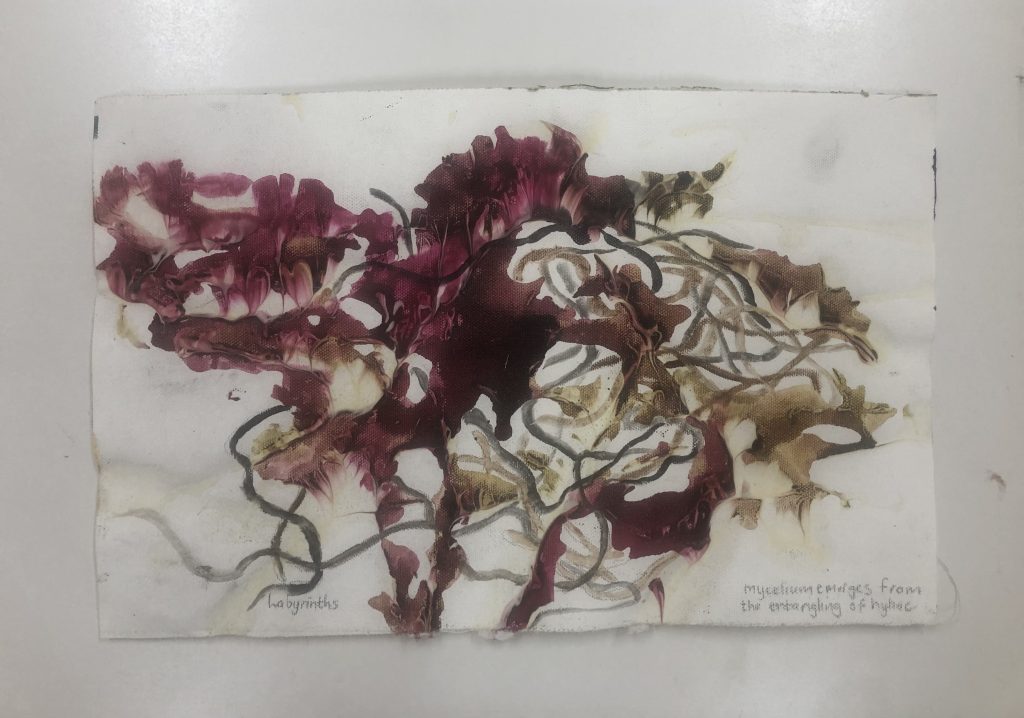

My making has to connect or be critically informed by my contextual framework for the extended writing I am preparing for in my Research project. I have looked at different artists to be inspired and learn from their practices. My tutors have suggested other methods that explore and think like me in many ways. I am aware that philosophical ideas such as Phenomenology, Material Agency and New Materialism play an essential part in why and how I make, as well as in the questions I deal with.
My research question is developing and stand currently as: “What is the role of artistic expression in evoking emotional responses and highlighting the interconnectedness, fragility, and vulnerability of nature and humanity?”
APPLICATION
Applying increasingly professional personal and graduate skills to initiate and sustain studies and emerging practice, and highly relevant practical, technical, and communication skills to articulate ideas and outcomes effectively.
Concerning my body of work, I have divided it into different sites of investigation and materials I work with. I feel this helped me to form a more cohesive body of work, which shows different sides of my creative research into materials and making. New ideas have been generated mainly through keeping a daily practice of making and exploration. My making became a container for my thoughts and questions. I have learned from Le Guin that we need something to ‘hold’ something else. I hope my contextual study will come such a container, made up of other containers (different work sites, I call ‘para’-sites) that inform.
I am active in student groups where work and making are regularly discussed. My reading also influences my making. I had the opportunity to exhibit at a local art exhibition and could apply many of the skills I had to develop in the course. For example, with the feather Installation, I challenged my technical abilities and became more confident in working and discussing my work and ideas with other artists and viewers.
REFLECTIVE COMMENTARY
When I started exploring making bird nests, I looked at weaving. I became aware of the importance of awareness on a level of being analytical and learning a new skill, but also the emotional of finding ways into something. Ravelling, unravelling, making knots, connecting, weaving, braiding, and gathering became doings – this is a vulnerable space as you need to leave room for learning and mistakes. I felt it was only when I allowed this space to open up and let exploring and understanding happen that I became more spontaneous and willing to enable accidents within my making.
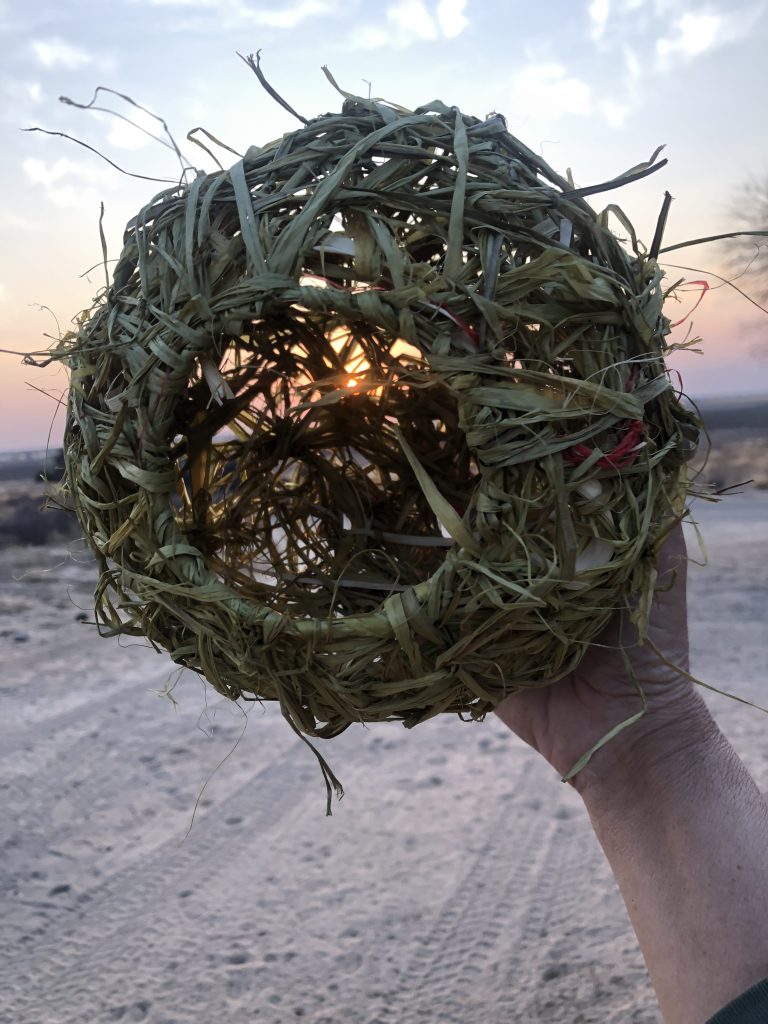
I continued to see if I could change the shape of the ‘nest’: my addition eventually ‘unravelled’.
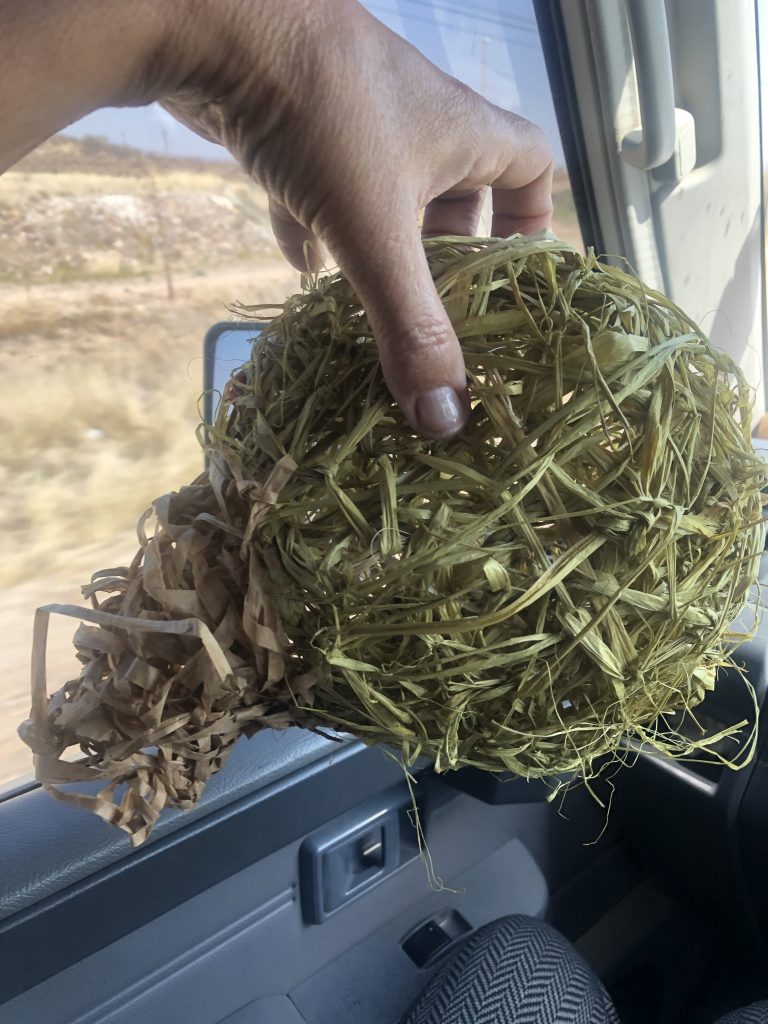
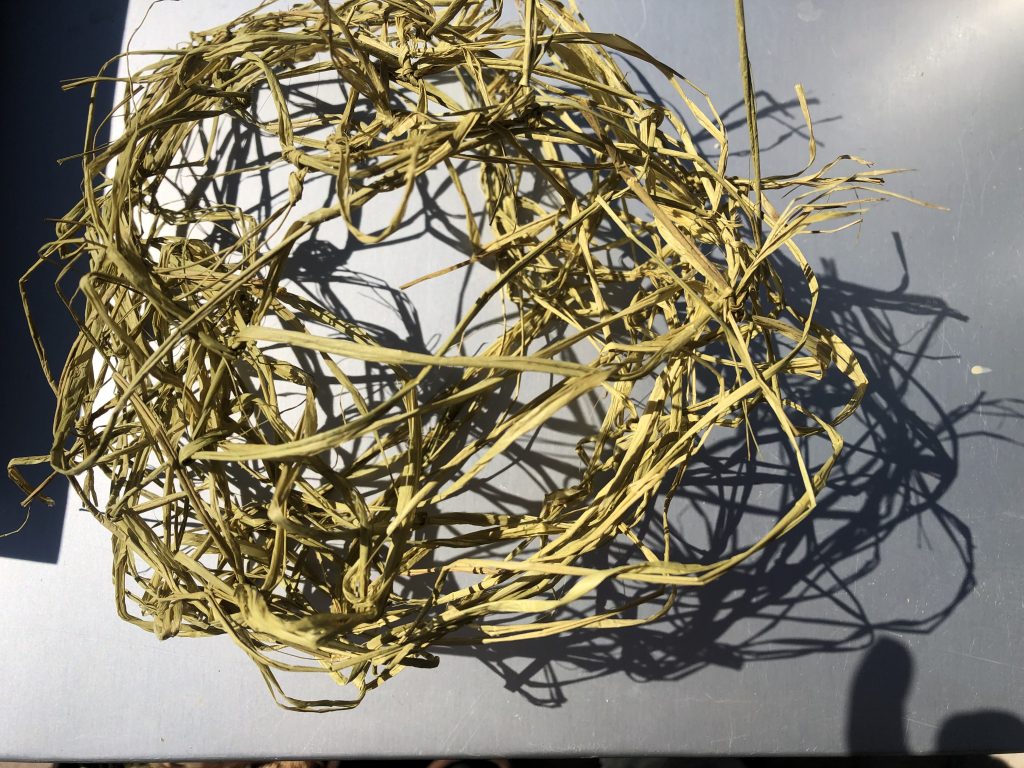
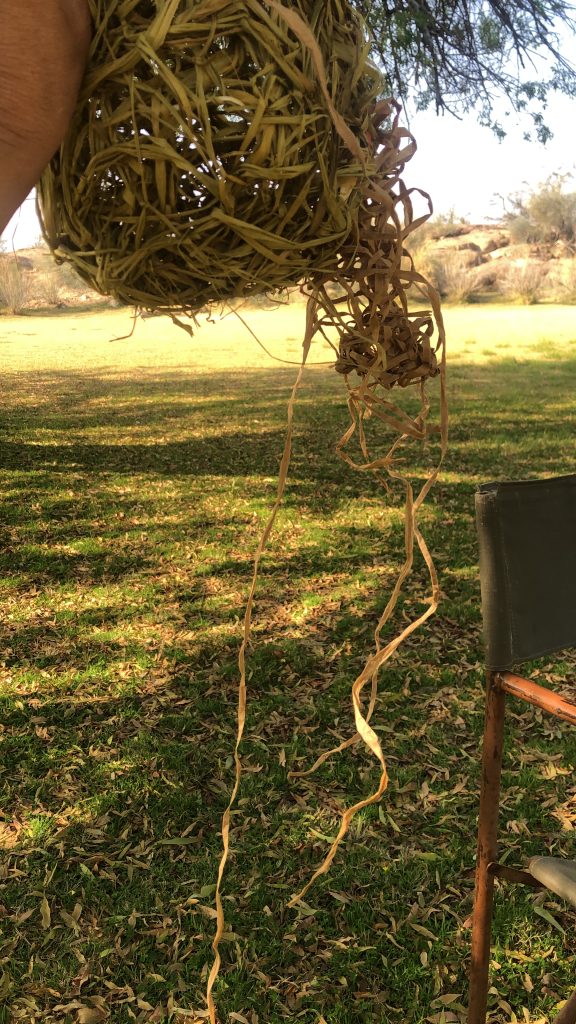
What is interesting to note is that the work shared here was not done in my studio but whilst I was on a camping holiday in a wildlife conservation area, and sometimes even whilst sitting in the car as we travelled. Looking at these images now, I find they are connected with nature and almost let character come into their space.
Interacting with nature and working outside
I am considering what curatorial approach I would take with the nests and wanted to explore spatial relationships between the materials and the landscape and think about temporal aspects of my making. Looking at the nests hanging outside on the veranda, I asked myself if they are still part of my process of enquiry in the fact that they change/differ constantly over time due to their interaction with the environment, be it the light, wind, rain, or gravity, due to age and decay. I see this as a way of following my material, but also to view my environment as part of the interconnectivity I am exploring in the research part of this course.
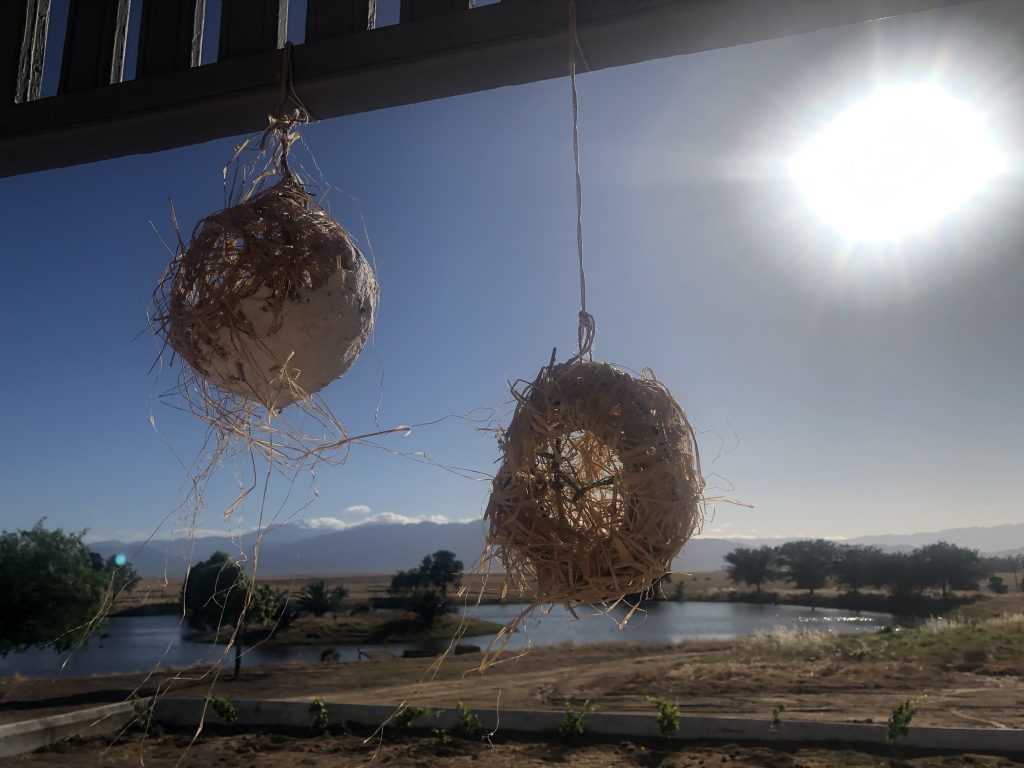
It makes me wonder if I could say they have become completed works – I see them as part of my enquiry process; can I show them as sharing part of a process with viewers, who will also interact differently with them and the space they are shown in? This work consists of two nests I made with raffia, but they differ in how I used structure and materials to form them. I can see other applications of these nests, by hanging them in a garden to use as bird feeders, or to document if birds would utilize them.
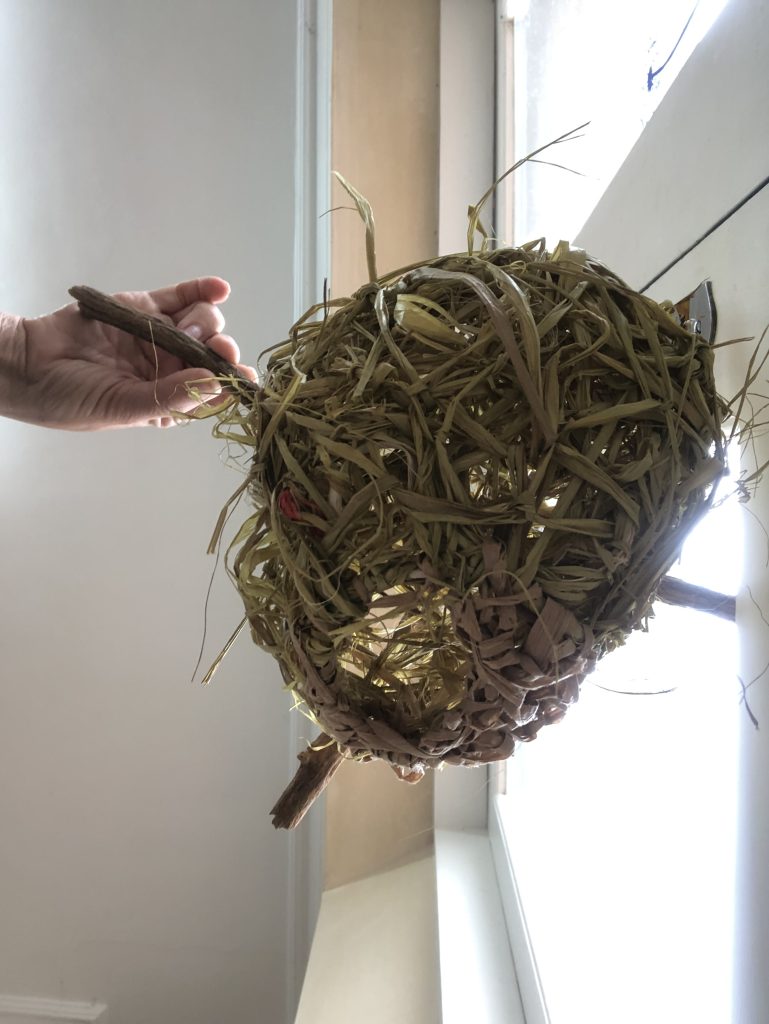
My research question pushed me to delve into various interests. I can explore different art forms, mediums, techniques and their impact on viewers’ emotions.
Feedback from a student who looked at my work in terms of the Research part:
Hi Karen,
I’ve really enjoyed looking at your blog and the drawings and sculptures. It’s a really great topic and you seem to me to have a good range of contextual research. The charcoal drawings of the nest have great textural qualities and great depth in terms of the contrast between the light and dark tones. I find the drawings quite ethereal and I particularly love the drawing as you look up at the nest. It’s exquisitely and very skillfully drawn. Great line and mark making. In your blog you give great descriptions around the nest and you mention the word care. I have Michelle W for research and she suggested to me the book Matters of Care by Maria Puig de la Bellacasa, for the links with human and non human care. Apologies if you’ve already covered this. I really love the use of the natural materials. Presumably when you use the wire for the larger work you explain why. We use willow a lot here but I guess you may not grow such trees there. I think you have a lot of good material, it’s just structuring it and pulling it all together. I’m finding the book by Gilda Williams really good in helping me break down exactly what I’m trying to convey and I’m following the advice of creating a very simple uncomplicated question and stating the why and how questions that relate to it in about five punchy paragraphs. I’m hoping to share my question with Cheryl soon after my submission for part 2 and if she says I’m on the right track, I’ll gladly send you a copy. I do hope this is helpful and if I can be of any further help just shout!
Many thanks. It was a joy to read your blog. Great work!